Top 8 Compressor Pedals From $20 to +$150
The Compressor Guide
The Compressor Effect
What’s a signal compressor?
Compressor pedals not only create sustain without the need of adding distortion/overdrive pedals to your rig, but they also attenuate the amplitude of the signal, filtering out spikes and reinforcing weak notes.

If you don’t know why Gary Moore is the lord of Sustain, stop reading and check this video. NOW.
This brings us one obvious advantage: we don’t need to oversaturate our original signal in order to get a Gary Moore’s sustain. OK, he did saturate a little his signal… I just miss him and I had to mention him somewhere.
The point here is that we can extend the sound even when playing clean chords. So this can be pretty useful for country or jazz players, for example.
How is this effect achieved?
How is this effect achieved?
The pedal controls how loud or soft your signal gets, so when a signal is too loud, a compressor limits this spike to a more reasonable level.
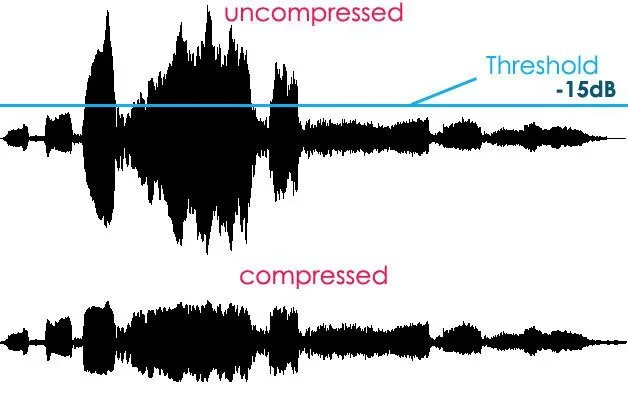
Conversely, when a signal is too soft or starts to fade, a compressor can boost the signal to even out dynamics and extends the duration of the notes, and hence, you no longer need to rely on an overdrive to achieve this same result.
Now, there are multiple ways to put this into practice and that’s what we’ll be covering in the next section.
Types of compressors
OTA
(Operational Transconductance Amplifier)
This is the most common type of compressor we can find today in the pedals market for its simplicity and good results. Kind of the standard type.
Although OTA compressors were known to distort the tone (either for good or bad), most of the new pedals have solved those issues improving the designs that were used on old pedals.
Multiband
Multiband compression is a digital compression technique, commonly found on computer software and modern pedals.
It separates your signal into separate frequency bands and compresses each individually to the utmost in carefully controlled dynamics.
Multiband compressors are a great option if you are looking for a total control of the compression.
Optical
Optical compressors attenuate your signal with a combination of a light source and a photoresistor.
These compressors are very smooth and natural sounding with slow release times.
Tube
Tube compressors are optical compressors boosted with tube stages that enhance the warmth of your tone.
Although these type of compressor is pretty rare, they are known to deliver the best compression effect.
Pedals like the Effectrode PC-2A or the Teletronix LA-2A are good examples of the finest compressor pedals ever built.
VCA
(Voltage Controlled Amplifier)
VCA compressors sound very clean and are less likely to color your tone.
They’re also very precise and responsive and often give you studio-style parameter controls (including Attack, Release, Ratio, Threshold, Knee, etc.)
The Keeley GC-2 Limiting Amplifier is a good example of a VCA compressor, albeit it’s hard to find
FET
(Field Effect Transistor)
Similar to VCA compressors, the FET type also offers the same parameter controls.
The main difference between VCA and FET is that the latter can bring additional color to your sound, which is under your own criteria to judge whether this is good or bad.
Do I Really Need One?
Do you like/practice/use any of the following?

- Tapping
- Economy picking + legato techniques
- Rock and blues leads seeking more sustain and tone
- Clean boost (level knob turned up and sustain knob turned down)
- Even bassists can take advantage of a compressor!
If yes, then you definitely should have a compressor pedal in your setup.
You will love it! BUT don’t rush.
Although compressor pedals are pretty straightforward, you must take your time to configure them properly so you can get the results you are looking for.
As any other effects type, maxing out the compression can produce weird or unnatural sounds, but that’s maybe what you want, so there is also room for other kind of usages. After all, what we want out of effects pedals is to experiment and try new sounds, so play around as much as you can!
Where Can I Find The Best Compressor Pedals?
The answer will totally depend on your needs and budget, but in any case, here are some general recommendations.
If you have never tried a compressor pedal before or if you have a tight budget I wouldn’t recommend you to spend more than $50. You can get pretty decent pedals like the JOYO JF-10 ($35).
Now, if you have more experience with pedals or you have a less limited budget, then I’d recommend you to check out the 100 to 200 dollar price range, where we have the following “sub-levels”.
- For $100 you have the classic compressor pedals: MXR M102 ($80) and Boss CS-3 (around the $100)
- In the top-notch level, we have the Xotic Effects SP Compressor or the Wampler Pedals Ego (+$150)
In the following table you can review the specifications of the different pedals we will cover in the next section:
Top 4 Compressor Pedals Under $100
Behringer CS400
Here we have the Boss CS-3 copycat, a cheapy plastic compressor pedal that, contrary to what you may be thinking, works really well.
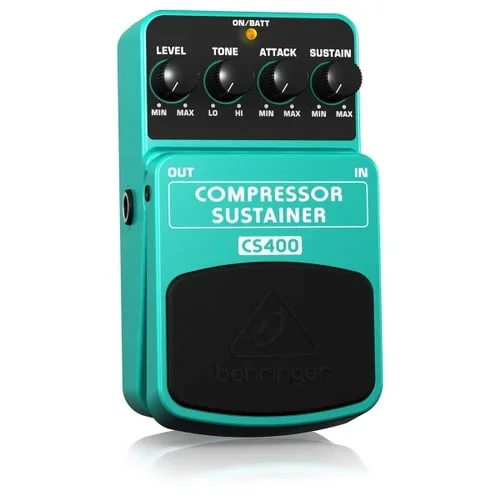
Beginner friendly Build construction
The most remarkable feature of this pedal is that it has dedicated Level, Tone, Attack and Sustain controls to fully control the compression parameters.
One of the best options for a home-only compressor pedal.
Official documentation can be found here (took me a while to actually find _any_documentation).
Joyo JF-10 Dyna
The Joyo JF-10 Dyna is a fantastic compressor pedal that replicates the classicRoss Compressor pedal ($200+) with pretty success.

Comparable to Boss CS-3 Ross Compressor copy Can’t adjust attack and release
With more than 200 positive reviews on Amazon, this pedal has increasingly attracted the attention of amateurs and pros alike. Here are some of the key features:
- Some people claim that it sounds better than the Boss CS-3 ($100)
- It barely adds noise to your original signal
- True bypass, which is the default these days
- Aluminum case, but not as durable as a Boss
- It also has a lid for an easy battery replacement
Wrapping up, if you don’t know what pedal to choose or you are new to compressors, don’t hesitate and pick JOYO Dyna. You won’t regret it
Mooer MCS2 Yellow Comp
The distinctive feature of the Mooer MCS2 is that it’s an optical compressor, contrary to other pedals within the same price range (~ $50) which are generally OTA compressors.

Affordable optical compressor Can’t adjust attack and release
What does that mean?
OTA isn’t worst than Optical, nor vice-versa. But the fact that it’s uncommon in this price range to find optical compressors makes it easier to experiment and get new sounds.
The MCS2 is a minimalistic micro pedal with no battery option and just three knobs to control the volume, the equalization and the compression level.
It has a very smooth and natural sound with slow release times
TC Electronic HyperGravity Compressor
The TC Electronic HyperGravity is an extremely flexible pedal with an innovative compression algorithm that makes it stand out from the competition.
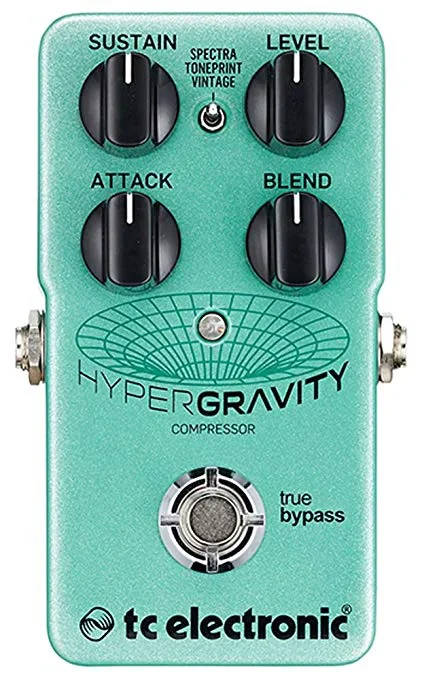
TonePrint! Can be hard to get the right sound
As with the other TC Electronic pedals, you can download some presets configurations from the official web. You can also create your own effects via the TonePrint editor software so you can keep it safe and share them with the world.
The HyperGravity has three different compressor modes:
- Spectra: the default compression mode
- TonePrint: to use the TonePrint-based compressor configurations
- Vintage: jump straight into old-school compression tones a la Ross. With this setting, you get all of the squeeze and squash associated with classical stompbox compression. It is perfect for percussive country tones, tight funk sounds or sweet Gilmour sustain.
One thing that I absolutely love about this pedal is that you can set the bypasseither to true bypass mode or buffered mode.
But what makes this digital compressor pedal special is that it uses a multiband compression algorithm that separates the input signal into 3 frequency bands and applies different amounts of compression to each one. This opens a new universe of possibilities.
This pedal has a LOT to play with, a superb quality, and absolute dynamic control while remaining affordable.
MXR M102 Dyna Comp
The MXR Dyna Comp has been (and still is) one of the most popular compressor pedals that ever existed along with the Boss CS-3.
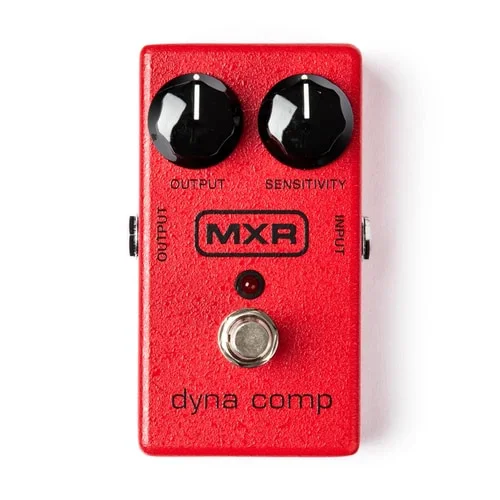
Durability, time tested Might be short on features
After all, they hit the markets in the seventies and are still relevant some decades later with just a few upgrades over the years. So, yes, it’s obvious that they are good products, otherwise, they would be gone long ago.
BUT, I would encourage you to NOT blindly go for them: there are tons of modern compressor pedals offering different features and sounds, so I’d recommend you to explore what’s in the market first and if nothing looks good enough for you, then come back for either the Dyna Comp or the CS-3.
Top 4 Compressor Pedals Over $100
Keeley Compressor Plus
Here we have the latest iteration of the pedal that put Robert Keeley company on the map: the Keeley Compressor.
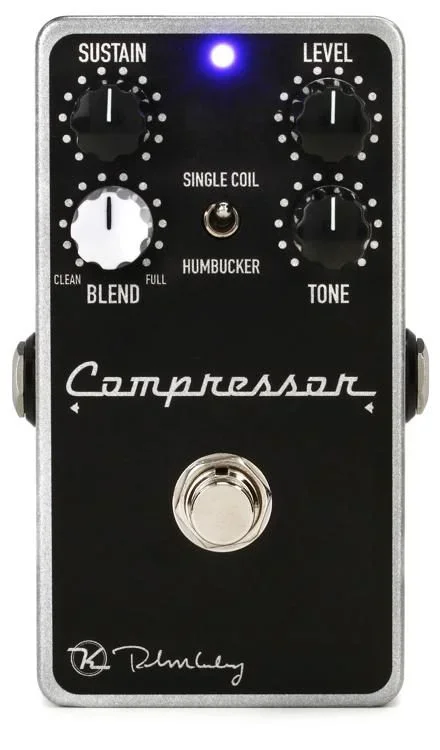
Since the first version was released more than 15 years ago, this completely made in the USA pedal has gathered worldwide acclaim and with this new version, they have renewed it following the latest compressor pedals trends, improving the former version in every respect while keeping all the good things that made this pedal famous.
What’s New Compared To The Previous Model?
Two new controls added:
- Blend: which allows you to bring in some of your dry signal along with the compressed signal for the best of both worlds: dynamic and fatter at the same time
- Tone: allows you to fine-tune the tone appropriately for any guitar
The Attack knob has been replaced by a two-position switch that automatically adjusts the attack/release for single coils or humbuckers.
The cool this is that the price has been reduced from $220 to around the $130.
How To Use It
Thanks to the new controls, the Keeley compressor isn’t just for heavy funk or chicken picking anymore.
Remove just the right amount of peaks for an ambient layer and then blend in the right amount of treble for a nice shimmer to your guitar.
Or use it with your favorite fuzz to create a wall of tone like you’ve never imagined.
For The Years To Come
Built with metal film resistors and best quality capacitors that translates into ultra-clean operation.
They also claim that they only use transistors to less than 1% tolerance.
All this precious circuitry is enclosed in a full metal case that will stand up to road abuse and give you many years of great sound and trouble-free operation.
Xotic Effects SP Compressor
Based on the beloved Ross circuit, this analog compressor promises to smooth the peaks and enhance the subtleties in a discreet manner.
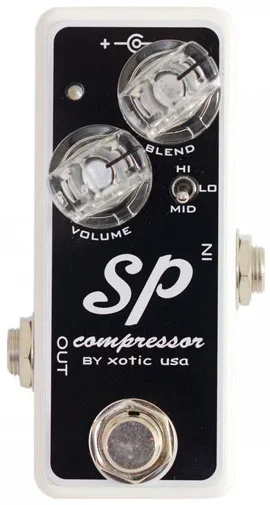
Improving Xotic Pedals With Higher Voltage Levels
WTF right? The guys from Xotic sell a step-up converter called “Voltage Doubler” that takes 9 volts DC and boosts it to an output voltage of 15V or 18V DC.
Turns out that this higher voltage level results in more headroom, which is beneficial for the some of the Xotic pedals, obtaining a noticeable performance boost reducing the sound compression and improving the pedal dynamics.
Believe it or not, some users have reported that this thing actually works really great, so give it a chance if you can!
Seymour Duncan Vise Grip
The Seymour Duncan Vise Grip puts the squeeze on your signal by using a classic VCA studio quality compression, with a powerful parallel blend.
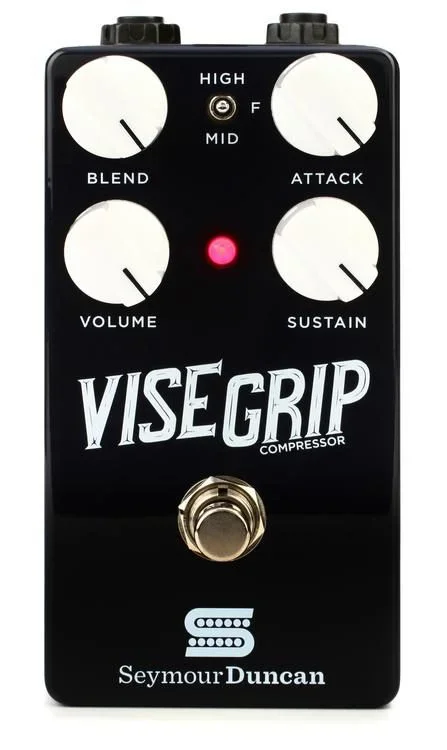
And like all Seymour Duncan pedals, the Vise Grip is made with high-quality components right here in the States.
How The Frequency Toggle Works
The Frequency toggle is extremely interactive with the Blend control, letting select frequency bands into the parallel circuit, with the center position keeping the full range intact.
The Mid and High positions cut all other frequencies from the dry signal, giving you full control of the compression equalization.
Selecting the Mid position and higher Blend setting adds a depth of character to any signal, and it sounds so good that you’ll never turn it off.
Using The 4 Knobs
- Blend: blend the clean signal with the compression for a more natural sound that gives your tone some space, preserving the instrument’s natural attack.
- Atack: regulates how quickly the compressor reacts to your initial pick attack with the circuit acting to compress the input signal.
- Volume: lets you match your non-compressed signal perfectly or use it as a boost feature when you kick the Vise Grip on
- Sustain: determines the length of sustain, just like in any other compressor
Sample Settings
Extracted from the official documentation, here are some of the effects you can get out of the Vise Grip:
- Clean Rythm: this will allow your chords to ring and sustain naturally
- Infinite Sustain: great for chords and better for single notes (just like Gary Moore used to do)
- Funky Chops: give your rhythmic chops and single-note melody lines a rounded edge that sounds great on the three treble strings
Wampler Pedals Ego Compressor V2
The Ego Compressor by Wampler Pedals, like the Ross & Dyna Comp, is an OTA compression pedal. This style of compression is particularly well suited to guitar, having an organic quality that lends itself well to the instrument.

Why This Pedal Is Here To Stay
The classic Ross Compressor and the MXR Dyna Comp are two models with a distinct compression sound that is still highly regarded today by many guitarists.
Problem is they were designed a few decades ago and, although they have received some upgrades over the years, these classic designs still drag their most known drawbacks: tonal coloration, a lack of parameter control, and a high level of signal noise.
The Ego Compressor takes the best parts of those classic design and takes it to a new level adding to the simplified 2-knob control set (Sustain & Level) additional knobs for Attack, Blend, & Tone.
Also, this pedal aims to provide a clean and transparent operation to avoid any tonal coloration or signal noise.
What’s New In The V2?
Not too much really. Following the new Wampler standards, all their pedals now mount the In/Out jacks at the top, instead of right and left, which can help to optimize the space of small-sized pedal boards.
How It Works
The Ego Comp is a complex compressor, that’s why you need to become very familiar with the controls if you want to get the most out of it.
It features Volume, Sustain, and Attack controls to dial in your preferred compression behavior, as well as a special Tone control which lets you go from nothing added to lots of sparkle and chime on top of your signal, adjustable to your preference.
It also features the fantastic Blend knob, letting you easily adjust the degree of compressed to natural signal.
If you’ve never tried a blend compressor before, you’re in for a treat! As with all Wampler Pedals products, the Ego Compressor includes a high-quality true-bypass switch which takes it completely out of the signal path when bypassed.
Should you use it after or before the gain pedals? What settings should you use for this or that? There is no right answer, so experiment and enjoy!
Wrapping Up!
You did it! We covered a lot of material in this guide I really hope going through it has helped you to learn something new about compressor pedals and that it also helped you to discover new pedals you might didn’t know about.
To close this up with an awesome video from Roland’s Effects 101 series, where you can learn all the basics of compressor pedals. Johnny DeMarco guides you through every knob in the Boss CS-3 explaining the effect that they have on the tone, as well as some pretty nice demos… Enjoy!